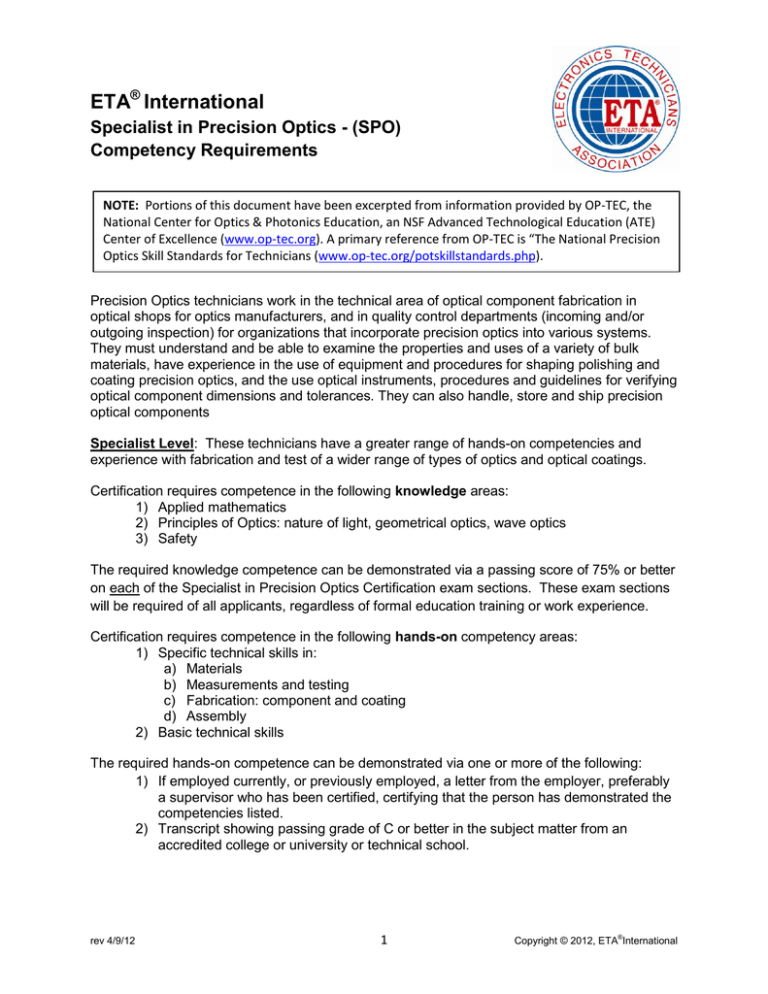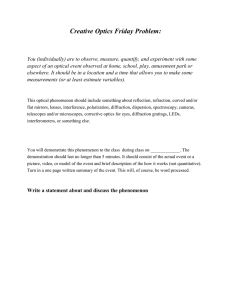Competencies - ETA International
advertisement

ETA® International Specialist in Precision Optics - (SPO) Competency Requirements NOTE: Portions of this document have been excerpted from information provided by OP-TEC, the National Center for Optics & Photonics Education, an NSF Advanced Technological Education (ATE) Center of Excellence (www.op-tec.org). A primary reference from OP-TEC is “The National Precision Optics Skill Standards for Technicians (www.op-tec.org/potskillstandards.php). Precision Optics technicians work in the technical area of optical component fabrication in optical shops for optics manufacturers, and in quality control departments (incoming and/or outgoing inspection) for organizations that incorporate precision optics into various systems. They must understand and be able to examine the properties and uses of a variety of bulk materials, have experience in the use of equipment and procedures for shaping polishing and coating precision optics, and the use optical instruments, procedures and guidelines for verifying optical component dimensions and tolerances. They can also handle, store and ship precision optical components Specialist Level: These technicians have a greater range of hands-on competencies and experience with fabrication and test of a wider range of types of optics and optical coatings. Certification requires competence in the following knowledge areas: 1) Applied mathematics 2) Principles of Optics: nature of light, geometrical optics, wave optics 3) Safety The required knowledge competence can be demonstrated via a passing score of 75% or better on each of the Specialist in Precision Optics Certification exam sections. These exam sections will be required of all applicants, regardless of formal education training or work experience. Certification requires competence in the following hands-on competency areas: 1) Specific technical skills in: a) Materials b) Measurements and testing c) Fabrication: component and coating d) Assembly 2) Basic technical skills The required hands-on competence can be demonstrated via one or more of the following: 1) If employed currently, or previously employed, a letter from the employer, preferably a supervisor who has been certified, certifying that the person has demonstrated the competencies listed. 2) Transcript showing passing grade of C or better in the subject matter from an accredited college or university or technical school. rev 4/9/12 1 Copyright © 2012, ETA®International Specialist in Precision Optics - (SPO) ETA®International Specialist-Level Knowledge Competencies – Certification as a “Specialist in Precision Optics” requires evidence of knowledge and competence in all of the knowledge areas for the Technician Level, and also in all of the following additional areas. I. Applied Mathematics 1) Understand and utilize basic math skills: a) Work with fractions, decimals, and percents, exponents, real & imaginary numbers, symbolically and graphically. b) Know basic units of measurements for distance/length, weight, and volume in English and Metric units and be able to convert between English and Metric units. c) Know the meaning of various unit measurement abbreviations such as micro, nano, pico, atto, and be able to convert one unit to another. d) Estimate answers to problems and round off numbers e) Understand precision, accuracy, and tolerance in measurements f) Apply the scientific method to general problem solving, to the design and collection of data, and to the analysis and effective presentation of results and conclusions 2) Understand and utilize basic algebra skills: a) Perform calculations using powers, roots, scientific and engineering notation, logarithms, decibels b) How to utilize formulas and to arrange equations to solve for specified unknowns c) Ratio and proportion 3) Understand and utilize basic geometry and trigonometry skills: a) Perform calculations using lines and angles (parallel and perpendicular lines) b) Perform calculations on perimeters and areas of rectangles, parallelograms, trapezoids, triangles, and circles (sine, cosine, tangent functions) c) Perform calculations on surface areas and volumes of boxes, cones, cylinders, and spheres d) Know definition of and how to use basic trig functions: sine, cosine, tangent 4) Understand graphs to include bar graphs, pie charts, and line graphs (linear, semi-log, log) 5) Read scale drawings II. Principles of Optics 1) Basic Nature of Light a) Light described as a ray b) Light described as a wave c) Characteristics of photons—energy, momentum, frequency, and wavelength d) Characteristics of light waves—amplitude, frequency, period, wavelength, wavefronts, electromagnetic spectra and propagation direction e) Reflection, scattering, and absorption of light in various media and at various interfaces 2) Geometric Optics a) Law of reflection b) Law of refraction (Snell’s law) c) Index of refraction/speed of light d) Critical angle & total internal reflection e) Refraction of light by prisms rev 4/9/12 2 Copyright © 2012, ETA®International Specialist in Precision Optics - (SPO) ETA®International f) Ray tracing to locate position, size, and orientation of images formed by systems of thin lenses and/or mirrors g) Optical and geometrical characteristics of concave, convex, and aspheric lenses and mirrors h) Use of thin-lens formulas to locate images i) f-number of a lens or mirror: meaning, use, and how to calculate it j) Brewster’s Angle k) Fresnel reflection 3) Wave Optics a) Characteristics of electromagnetic spectra b) Principle of superposition and interference of light waves c) Standing waves (nodes and antinodes) d) Formation of interference fringes e) Diffraction of light waves through small openings and around sharp edges f) Single-slit and double-slit diffraction patterns g) Diffraction with gratings h) Diffraction-limited optics i) Characteristics of randomly polarized, plane polarized, circularly polarized, and elliptically polarized light j) Producing polarized light k) Detecting polarized light l) Bragg’s law m) Birefringence III. Safety 1) Basic laser safety as defined in ANSI Z136.1-2007 American National Standard for Safe Use of Lasers 2) Laser safety concepts a) Biological effects of laser radiation on the eye and skin with all wavelength from 180nm to 1mm b) Understand the significance of specular and diffuse reflections c) Understand the non-beam hazards d) Understand laser classification e) Maximum Permissible Exposure (MPE), Normal Hazard Zone (NHZ) f) Control measure for normal laser operation and during service with defeated interlocks. g) Familiarity of the US code of federal regulation 1040.10, Federal Laser Product Performance Standard. Be able to identify if a laser or laser system complies with the code. 3) Knowledge of other basic safety procedures that are likely in most photonics applications: a) Electrical b) Chemical (e.g., optics cleaning using acetone - flammability & explosion potential) c) Materials (e.g., MSDS – Material Safety Data Sheets) rev 4/9/12 3 Copyright © 2012, ETA®International Specialist in Precision Optics - (SPO) ETA®International Specialist -Level Hands-On Competencies – Certification as a “Specialist in Precision Optics” requires evidence of training and/or experience and competence in all of the areas for the Technician-Level, and also in all of the following additional areas: I. Specific technical skills 1) Materials identification, inspection, qualification a) Determine optical, chemical, thermal, and mechanical properties of selected materials from handbooks, supplier specification sheets, and Internet sources and assess their relevance to specified manufacturing processes. b) Review incoming material certification sheets to match print specifications. c) Maintain prescribed documentation of bulk materials using a job jacket or its equivalent. d) Inspect and evaluate physical properties of materials for hardness and chemical stability, for defects such as cleavage, inclusions, bubbles, striae, scratches, bulk stress, scattering, fractures, and impurities, and assess their relevance to specified manufacturing processes. e) Apply chemical and material handling safety procedures, including knowing handling for optical materials that may present a hazard, to ensure personal safety, prevent material damage, avoid contamination, and maintain material identification. f) Understand the properties and work with at least two types of materials for optics (e.g., glasses, ceramics, metals, plastics) 2) Measurements and testing a) Identify the functions and shapes of various optical components. b) Use a loupe to identify bulk material bulk defects such as inclusions, bubbles, striae, scratches, and fractures. c) Measure optical surface characteristics during fabrication using appropriate equipment (e.g., scratch and dig inspection box, microscope, loupe, magnifiers, calipers, micrometers, depth gauges, spherometers). d) Inspect finished products following accepted procedures and quality assurance criteria to ensure compliance with established specifications by measuring physical and optical properties (shape, reflectivity, transmission, surface quality/roughness) using appropriate equipment, including interferometer, autocollimator, profilometer, reflectometer. e) Measure conformance and performance via mechanical and/or optical means and record any deviations from specifications and recommend corrective actions. f) Comply with specified handling, packaging, & shipping conditions for finished optical components, coordinating with quality assurance personnel to ensure compliance to design specifications and documentation requirements. g) Use polarization measurement techniques to identify internal stress. h) Use hardness testing procedures and equipment such as Mohs scratch and Knoop hardness instrument. i) Measure the refractive index of optical materials using procedures such as Abbe refractometer. j) Measure reflectance and/or transmission of finished and coated optics. k) Use statistical process control guidelines for sampling finished components. rev 4/9/12 4 Copyright © 2012, ETA®International 3) Optical Component Fabrication a) Operate appropriate equipment to shape optical materials to dimensional specifications (e.g., cutoff and wire saws, abrasive grinding machines, and coring machines). b) Operate appropriate equipment and perform procedures for tooling, blocking, generating, shaping, beveling, grinding, polishing, and centering. c) Select appropriate abrasives including grit size and composition to achieve design tolerances and specifications for surface quality for specific materials. d) Understand the interaction between various materials used in high-tolerance optics fabrication such as hot pitch and acetone. e) Prepare fixtures for mounting starting material as part of the fabrication process. f) Operate appropriate grinding and polishing machines to generate planar and spherical surface optics. g) Prepare appropriate bevels on optics. h) Maintain and prepare conduits and pumps for cooling and slurry delivery to work surfaces. i) Clean optics to appropriate specification levels using proper techniques. j) Store optics in appropriate containers with environmental controls. k) Comply with specified handling, packaging, & shipping conditions for finished optical components l) Apply appropriate maintenance instructions from manufacturers’ equipment manuals. m) Operate appropriate grinding and polishing machines to generate aspheric, cylindrical, or toric optics. n) Optimize fabrication tools and parameters to increase efficiency and quality. o) Assess CNC performance against established specifications. p) Design new tooling and evaluate performance of existing tooling. q) Assist in the selection of fabrication processes and their sequencing. r) Recommend process changes to increase quality and efficiency. 4) Optical Component Assembly a) Interpret assembly drawings. b) Apply proper cleanroom and airflow workbench procedures. c) Use proper alignment techniques for assembly processes including aligning physical and optical centers per specifications. d) Use appropriate optical adhesives or epoxies (UV, etc.). e) Mount optical components in mechanical assemblies. f) Align and cement/pot elements in cells. g) Select and use appropriate optical adhesives or epoxies (UV, etc.). 5) Optical Coating Fabrication a) Interpret drawings for coating specifications. b) Clean and inspect optics for coating using accepted procedures. c) Load and operate coating equipment to apply thin film coatings (single and multilayer) to design specifications. d) Operate appropriate equipment to test coating performance on witness samples and verify results with drawing specifications. II. Basic technical skills 1) Read and interpret technical drawings and specifications for dimensions and tolerancing and data reference 2) Read and understand CAD drawings 3) Read a basic optical layout schematic rev 4/9/12 5 Copyright © 2012, ETA®International Specialist in Precision Optics - (SPO) ETA®International 4) Operate common machine shop equipment such as lathes, band saws, drill presses, and milling machines. 5) Program CNC controllers according to specifications. 6) Collect data and use computer spreadsheet software (e.g., Excel) for data collection, reduction, presentation. 7) Identify and comply with established regulatory electrical, chemical, and laser codes, including laser safety if laser devices are used in testing. 8) Detect malfunctioning equipment, including recognizing operation out of specifications, and notify appropriate personnel for repair. 9) Apply accepted standards to maintain work area cleanliness. 10) Use established instructions for entering and operating in cleanrooms (if cleanroom operation is required) 11) Identify and work within project constraints (physical, schedule, and budget) 12) Detect malfunctioning equipment, including recognizing operation out of specifications, and adjust or repair as necessary and/or notify appropriate repair personnel. End of Specialist in Precision Optics Competencies Listings: (with 3 major Knowledge categories and 2 major Hands-On categories) Find An ETA Approved School Site: http://www.eta-i.org/eta_schools.html Find An ETA Test Site: http://www.eta-i.org/testing.html rev 4/9/12 6 Copyright © 2012, ETA®International Specialist in Precision Optics - (SPO) ETA®International Suggested Study Material and Resources: (also see websites for even more detail information) LIGHT- Introduction to Optics and Photonics (hardcover); Judith Donnelly, Nicholas Massa; ISBN 978-09815318-09; New England Board of Higher Education; Jan. 2010; pgs.377. Also available in paperback, black & white paperback, and PDF download at http://stores.lulu.com/photon2 Optics for Engineers; Charles DiMarzio; ISBN 978-14398072-5-5; CRC Press; Aug. 2011; pgs.558. http://www.crcpress.com/product/isbn/9781439807255 Optical Communications Essentials; Gerd Keiser; ISBN 978-00717379-99; McGraw-Hill Companies; July 2003; pgs.396. Understanding Lasers: An Entry-Level, 3E; Jeff Hecht; ISBN 978-04700889-06; WileyIEEE Press; June 2008; pgs.496. Optics, 4E; Eugene Hecht; ISBN 978-0805856-63; Addison Wesley; Aug. 2001; pgs.680. Basic Electro-Optics for Electrical Engineers; Glenn D. Boreman; ISBN 978-08194280-66; SPIE Publications; March 1998; pgs.97. http://spie.org/x648.html?product_id=294180 NOTE: The following are to be used as a resource, not intended to replace the approved course training in photonics or precision optics, required in order to sit for the certification qualifying exams. OP-TEC websites: http://www.op-tec.org/; http://www.op-tec.org/OPCN.php; http://www.op-tec.org/index-1.php; http://www.op-tec.org/index-3.php SPIE open access self-study resources: Fundamentals of Photonics, 10 tutorial modules written by experts, part of a project funded by the Center for Occupational Research and Development (CORD) and the Scientific and Technological Education in Optics and Photonics (STEP), and supported by SPIE and other organizations. http://spie.org/x17229.xml Optipedia, a collection of encyclopedic articles on key topics in optics and photonics. Text, equations, and graphs were originally published in SPIE Press books. http://spie.org/x32276.xml Other SPIE publications in their “Field Guides” series, http://spie.org/x647.xml, (mainly aimed at engineers, but could also be useful to technicians): Field Guide to Infrared Systems, Detectors, and FPAs, Second Edition Field Guide to Optical Fiber Technology Field Guide to Geometrical Optics Field Guide to Lasers Field Guide to Polarization Field Guide to Infrared Systems Field Guide to Laser Pulse Generation Field Guide to Optical Thin Films Field Guide to Interferometric Optical Testing rev 4/9/12 7 Copyright © 2012, ETA®International



